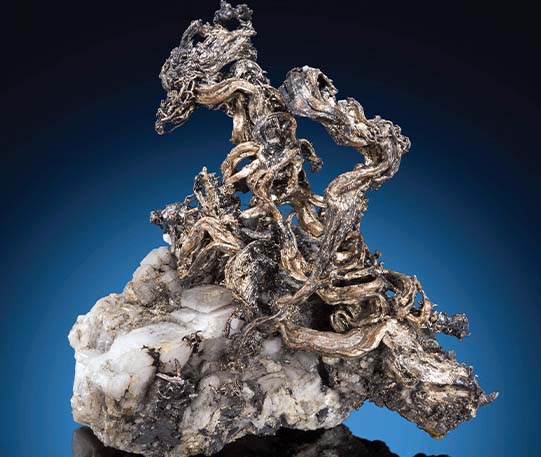
By Steve Voynick
As a precious metal, silver has always taken a backseat to gold in terms of rarity, value, color, density, and workability. Nevertheless, silver has a rich history and a mining story quite different from that of gold.
Although silver occasionally occurs as a native metal, it is most often found alloyed with gold or as sulfide minerals associated with lead, zinc, and copper (base-metal) ores.
Historic Booms and Modern Methods
The five historic silver-mining booms took place in ancient Greece, the Roman Empire, central Europe’s Erzgebirge, the Spanish colonies of Peru and Mexico, and the western United States. During each of these booms, the primary mines brought silver to the surface as the main economic mineral. But since 1900, after many primary mines had depleted their rich ores, silver has been obtained increasingly as a by-product of other mining types.
Today, 93 percent of gold production comes from primary gold mines, while primary silver mines account for only about one-quarter of silver production. The remaining 75 percent of silver output is a by-product of lead, zinc, copper, and gold mining. Therefore, silver production is not driven by the silver price, nor is it dependent upon the output of primary silver mines. Instead, it is driven mainly by the combined output of gold and base-metal mines that recover and sell by-product silver profitably regardless of the silver price.
Native gold usually contains between 10 and 20 percent silver, and both metals are recovered through the cyanidation-extraction process. The world’s gold mines now produce 100 million troy ounces of by-product silver per year. Most base-metal ores contain only about one troy ounce of silver per tonne. But because of its enormous scale, base-metal mining provides almost 500 million troy ounces of by-product silver each year.
Primary Mining Faces Trouble
While gold and base-metal mining are currently thriving, primary silver mining is in trouble. Since 2010, the leading primary silver mines’ average ore grade has dropped from 15 troy ounces per tonne to just nine troy ounces. The list of the world’s 20 largest silver producers includes only six primary silver mines. In recent decades, the voluminous output of gold and base-metal mining has sent silver production soaring. One-third of all the silver ever mined throughout history has been mined in the last 25 years. World silver production reached an all-time high of 860 million troy ounces in 2015 but has since declined.
The United States Geological Survey estimates all the silver ever mined at 60 billion troy ounces (about 1.92 million tonnes). That amount would fill a theoretical cube 170 feet on a side. For comparison, all the gold ever mined—6.3 billion troy ounces—would occupy a much smaller cube measuring only 71 feet on a side. It might seem that the volume of the hypothetical silver cube would be considerably smaller. But silver has only half the density of gold and occupies much less volume. One cubic foot of gold, roughly the size of a small wastepaper basket, weighs 1,206 pounds, while the same volume of silver weighs only 655 pounds.
Disappearing Due To Industrial Uses
Roughly 90 percent of all the gold ever mined still exists. But that is not the case with silver, which, unlike gold, is primarily an industrial metal. The Silver Institute estimates that 90 percent of all the silver ever mined has been lost, mainly through dissipative and non-recoverable industrial uses.
The world’s current silver-bearing ore reserves, including primary-silver, gold, and base-metal ores, contain just over 18 billion troy ounces of silver. Despite this seemingly impressive number, these reserves will last only 20 years at the current rate of mining. And geologists have little hope of finding any significant new primary silver deposits.
Although it cannot compare to gold as a precious metal and its glory days of mining are behind it, silver has quite a story of its own.
If you enjoyed what you’ve read here we invite you to consider signing up for the FREE Rock & Gem weekly newsletter. Learn more>>>
In addition, we invite you to consider subscribing to Rock & Gem magazine. The cost for a one-year U.S. subscription (12 issues) is $29.95. Learn more >>>














